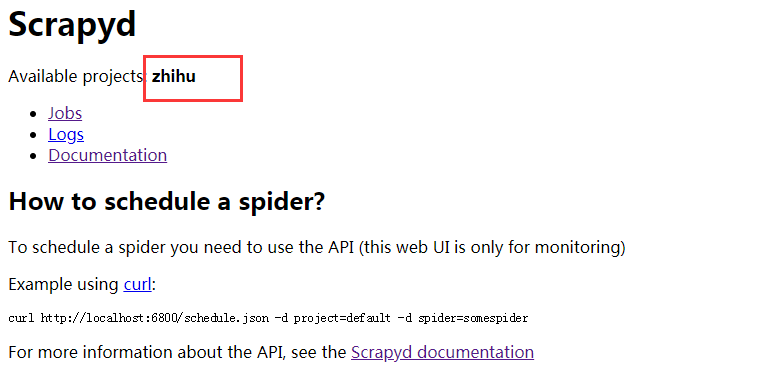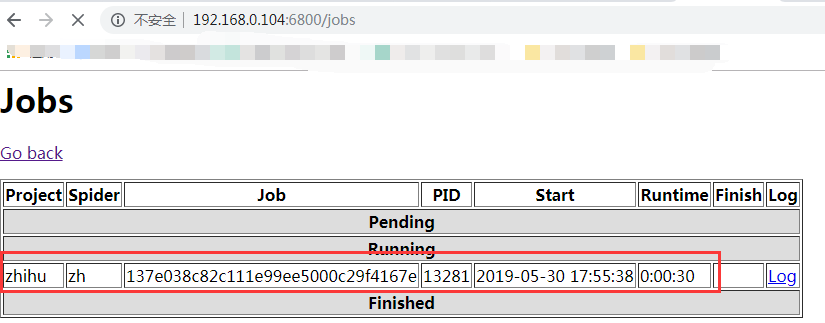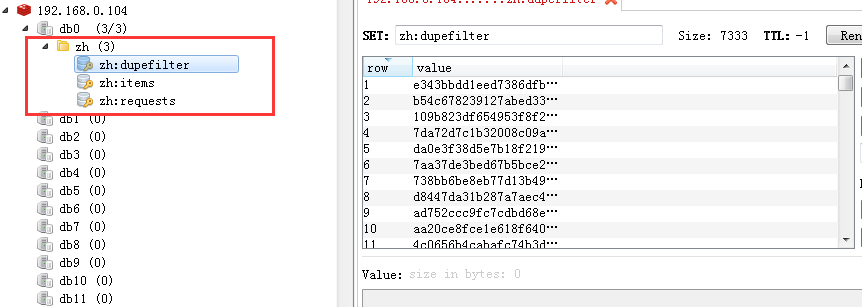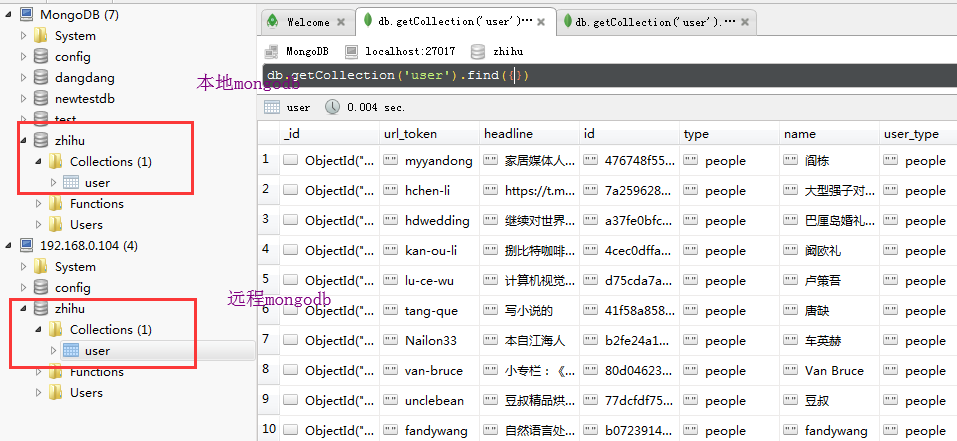一、环境搭建
由于条件有限,一台虚拟机,一台笔记本。
- 在虚拟机上装上mongodb数据库、redis数据库、redis_scrapy、pymongo、scrapyd
- 在本地电脑上装上monodb数据库、redis数据库、redis_scrapy、pymongo、scrapyd-clientl、scrapyd-api
二、修改爬虫项目的settings
如果使用分布式爬虫,配置文件需要做以下修改:
# -*- coding: utf-8 -*- # Scrapy settings for zhihu project # # For simplicity, this file contains only settings considered important or # commonly used. You can find more settings consulting the documentation: # # https://doc.scrapy.org/en/latest/topics/settings.html # https://doc.scrapy.org/en/latest/topics/downloader-middleware.html # https://doc.scrapy.org/en/latest/topics/spider-middleware.html BOT_NAME = 'zhihu' SPIDER_MODULES = ['zhihu.spiders'] NEWSPIDER_MODULE = 'zhihu.spiders' # Crawl responsibly by identifying yourself (and your website) on the user-agent #USER_AGENT = 'zhihu (+http://www.yourdomain.com)' # Obey robots.txt rules ROBOTSTXT_OBEY = False # Configure maximum concurrent requests performed by Scrapy (default: 16) #CONCURRENT_REQUESTS = 32 # Configure a delay for requests for the same website (default: 0) # See https://doc.scrapy.org/en/latest/topics/settings.html#download-delay # See also autothrottle settings and docs #DOWNLOAD_DELAY = 3 # The download delay setting will honor only one of: #CONCURRENT_REQUESTS_PER_DOMAIN = 16 #CONCURRENT_REQUESTS_PER_IP = 16 # Disable cookies (enabled by default) #COOKIES_ENABLED = False # Disable Telnet Console (enabled by default) #TELNETCONSOLE_ENABLED = False # Override the default request headers: DEFAULT_REQUEST_HEADERS = { 'Accept': 'text/html,application/xhtml+xml,application/xml;q=0.9,*/*;q=0.8', 'Accept-Language': 'en', 'User-Agent': 'Mozilla/5.0 (Windows NT 6.1; Win64; x64) AppleWebKit/537.36 (KHTML, like Gecko) Chrome/74.0.3729.169 Safari/537.36', ':authority': 'www.zhihu.com' } # Enable or disable spider middlewares # See https://doc.scrapy.org/en/latest/topics/spider-middleware.html #SPIDER_MIDDLEWARES = { # 'zhihu.middlewares.ZhihuSpiderMiddleware': 543, #} # Enable or disable downloader middlewares # See https://doc.scrapy.org/en/latest/topics/downloader-middleware.html #DOWNLOADER_MIDDLEWARES = { # 'zhihu.middlewares.ZhihuDownloaderMiddleware': 543, #} # Enable or disable extensions # See https://doc.scrapy.org/en/latest/topics/extensions.html #EXTENSIONS = { # 'scrapy.extensions.telnet.TelnetConsole': None, #} # Configure item pipelines # See https://doc.scrapy.org/en/latest/topics/item-pipeline.html ITEM_PIPELINES = { # 'zhihu.pipelines.ZhihuPipeline': 300, 'zhihu.pipelines.MongoPipeline': 300, 'scrapy_redis.pipelines.RedisPipeline': 301, } # Enable and configure the AutoThrottle extension (disabled by default) # See https://doc.scrapy.org/en/latest/topics/autothrottle.html #AUTOTHROTTLE_ENABLED = True # The initial download delay #AUTOTHROTTLE_START_DELAY = 5 # The maximum download delay to be set in case of high latencies #AUTOTHROTTLE_MAX_DELAY = 60 # The average number of requests Scrapy should be sending in parallel to # each remote server #AUTOTHROTTLE_TARGET_CONCURRENCY = 1.0 # Enable showing throttling stats for every response received: #AUTOTHROTTLE_DEBUG = False # Enable and configure HTTP caching (disabled by default) # See https://doc.scrapy.org/en/latest/topics/downloader-middleware.html#httpcache-middleware-settings #HTTPCACHE_ENABLED = True #HTTPCACHE_EXPIRATION_SECS = 0 #HTTPCACHE_DIR = 'httpcache' #HTTPCACHE_IGNORE_HTTP_CODES = [] #HTTPCACHE_STORAGE = 'scrapy.extensions.httpcache.FilesystemCacheStorage' MONGO_URI="localhost" MONGO_DATABASE="zhihu" SCHEDULER = "scrapy_redis.scheduler.Scheduler" DUPEFILTER_CLASS = "scrapy_redis.dupefilter.RFPDupeFilter" # SCHEDULER_PERSIST=True #爬取的requests以及dupefilter会保存在数据库中 REDIS_URL = 'redis://root:bright@192.168.0.104:6379' # REDIS_URL = 'redis:127.0.0.1:6379'
在以前的配置文件中加入:
'scrapy_redis.pipelines.RedisPipeline': 301, #pipeline配置中加入 SCHEDULER = "scrapy_redis.scheduler.Scheduler" DUPEFILTER_CLASS = "scrapy_redis.dupefilter.RFPDupeFilter"
这样完成了增量式的爬虫,但还不是分布式的爬虫。
三、scrapyd部署爬虫项目
1、在爬虫项目的scrapy.cfg中进行如下修改
# Automatically created by: scrapy startproject # # For more information about the [deploy] section see: # https://scrapyd.readthedocs.io/en/latest/deploy.html [settings] default = zhihu.settings [deploy] url = http://192.168.0.104:6800/addversion.json #表示要上传主机的ip project = zhihu
详细配置可参考:https://scrapyd.readthedocs.io/en/latest/api.html
2、在linux主机上先启动scrapyd服务

3、上传项目
这样可以上传项目到服务上,并且访问网址查看当前的状态

目前没有上传任何项目,此时进行上传,笔者是在pycharm中直接上传的

此处可能有坑:
(1)报错一
'scrapyd-deploy' 不是内部或外部命令,也不是可运行的程序 或批处理文件
这时可以需要在你当前python环境的目录下建立scrapyd-deploy.bat文件,里面填充,注意是自己的python路径以及scrapyd-deploy路径,因为这是在windows下执行命令。
"C:UsersAdministratorEnvsautomaticScriptspython.exe" "C:UsersAdministratorEnvsautomaticScriptsscrapyd-deploy" %*
(2)报错二
builtins.AttributeError: 'int' object has no attribute 'splitlines'
这是因为版本不匹配的原因,将linux服务器上的相应包进行回退
Scrapy==1.6.0 Twisted==18.9.0
参考文章:https://blog.csdn.net/qq_29719097/article/details/89431234
当一切顺利后,可以查看是否上传成功

已经上传成功,那么在linux上如何开启爬虫呢?
scrapyd中有很多接口,包括如何工作之类的接口,但都是以url来进行调度的,在这里可以使用scrapyd-api,这是将scrapyd进行封装,以方法的方式进行调度,比较简单,进行相应的python环境中就可以使用了。
(4)启动linux上的爬虫项目
在启动前先确保linux上的redis,以及mongodb服务已经开启,因为配置文件中进行了配置,在这里利用scrapy-api进行开启任务。详细使用查看https://python-scrapyd-api.readthedocs.io/en/latest/usage.html#calling-the-api

可以在web上查看目前状态

(5)查看数据库
可以查看redis数据库,里面包含请求requests、item、dupefilter数据

另外,mongodb中的数据也进行了分布式的爬取,不同主机爬取的放入不同主机下的mongodb数据库中

这样就完成了分布式的爬取。
四、总结
(1)一系列包的安装
(2)linux服务器上开启scrapyd、mongodb、redis服务
(3)本地部署上传(更改scrapy.cfg文件,scrapyd-deploy命令上传(需要安装scrapyd-client))
(4)利用scrapyd-api在python环境中进行开启爬虫
(5)本地同时利用scrapy crawl spider命令进行爬取